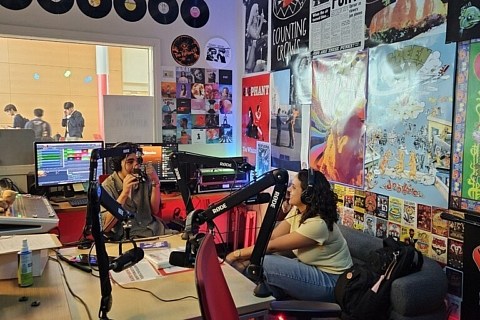‘Hand in mine
Into your icy blues
And then I say to you
We could take to the highway…’
With the first lines of “Demolition Lovers,” the final song off My Chemical Romance’s first album, the lore and speculation over the couple referenced in the song was born.
For many years now, I have been delighted by the “Life on the Murder Scene” cover art, a live CD and DVD set by My Chemical Romance released after the successor of their second album. It includes live performances, music videos, a live CD and a plethora of photos featuring the Demolition Lovers. But this time, they’d used live models instead of comics and paintings.
I’m going to track down the models from that iconic photoshoot and update you on what they’ve been up to since that fateful photoshoot in 2005. What better way to continue love month than with the story of a man, a woman and the corpses of a thousand evil men?
In 2002, My Chemical Romance released their debut record with New Jersy label Eyeball Records, home to bands like Thursday and Murder by Death. MCR was pretty new on the scene, only having formed in September 2001.
The album, “I Brought You My Bullets, You Brought Me Your Love,” referenced a Bonnie and Clyde-inspired couple running away from the law. The chase isn’t successful, and they die together in “a hail of bullets.” With that, the album closes, and the story is out of mind.
Until 2004.
“Three Cheers for Sweet Revenge,” My Chemical Romance’s sophomore effort, was initially under the working title of “Demolition Lovers II.” But that is not the only thing to suggest a connection to the infamous couple. Their cover art, painted by vocalist Gerard Way, puts a face to the pair. The CD lining hinted at a concept album telling fans that this was the story of “a man, a woman and the corpses of a thousand evil me.” This references a song from the band’s debut, “Drowning Lessons,” where a lyric speaks of “a thousand bodies piled up,” further solidifying the idea that the lovers were concepts across both albums.
So what is the concept?
“[Revenge is] the story of a man and a woman who are separated by death in a gunfight and he goes to hell only to realize by the devil telling him that she’s still alive,” said Gerard Way. “The devil says he can be with her again if he brings the devil the souls of a thousand evil men and the man agrees to do it, and so the devil hands him a gun. That was the idea behind the concept, the record ended up being much more about loss and real life than anything, so I would say it’s a good split.”
The album was the opposite of a sophomore slump, catapulting the band into the international spotlight. The fans ran with the concept, finding new details and interpretations of the songs and how they fit into the story of the lovers. By the time “Life on the Murder Scene” came out, they were hungry for more. The CD had three bonus songs, two of which were demos that had never been heard before. It also had a documentary and a selection of music videos and live performances. Encompassing the band’s vision, the album’s story, and the fan’s expectations weren’t going to be an easy job. But it was one P.R. Brown was happy to take on.
At the time, P.R. Brown was already an established photographer/music video director extraordinaire. He’s done work with Motley Crue, Billy Corgan, Static-Z, Killswitch Engage and Ween to name a few. The decision to make him the art director and photographer for “Life on the Murder Scene” proved to be a solid choice.
The cover of the CD/DVD was a recreation of the cover of ‘Three Cheers for Sweet Revenge,” originally drawn by lead singer Gerard Way, who’d attained a degree in fine arts from the School of Visual Arts in New York, often made artwork for the band. The concept for the LOTMS shoot was to recreate the original album’s cover, only using real-life models instead.
The models chosen for the job were Jamisin Matthews and Jaime Andrews. The photos were stunning, featuring the lovers splattered in crimson blood. Brown switches up the angles and poses, sometimes to recreate Gerard’s drawings, sometimes to fit his own vision.
The final products graced the jacket and booklet of the CD/DVD, fueling fans’ imaginations and cosplay efforts for years to come.
Even after My Chemical Romance’s initial break-up in 2016, the fandom around the band did not die. Following their reunion in 2020, fervor for the band has only increased, as have the questions surrounding the band’s lore and history. This is what led me to wonder where the models have been since I last saw them gracing the cover of one of my favorite albums.
Jamisin Matthews
Jamisin Matthews is an actor, model, musician, photographer and fight choreographer. Most recently, he starred in a film adaptation of Mary Shelly’s Frankenstein. One of the things he’s most well-known for, however, is modeling as the face of Leon Kennedy from Resident Evil: Operation Raccoon City.
His career is alive and well, with him pivoting more towards films. A pandemic hasn’t kept him down, as he currently has two new films in production.
Jamie Andrews
Jaime Andrews is a writer, actress, model and producer. Jaime has been acting since she was a child, doing children’s theater and children’s television in Long Island. Her career started with gig work and television show pilots through the early 2000s, eventually heading to the West Coast in 2005. There, she joined a theater company, eventually climbing the ranks and becoming a business manager and managing director. Somehow, she still found time to write for magazines and act in short films.
Jaime became a well-respected commercial actor. Most recently, she married fellow Sacred Fools Theater Company actor Curt Bonnem in 2020. She has also written a short film, which is in production now.
So if you’ve ever wondered who the models behind the demolition lovers on LotMS were and where they are today, now you know. I hope you’ve enjoyed going down this rabbit hole as much as I have.





Recent Comments